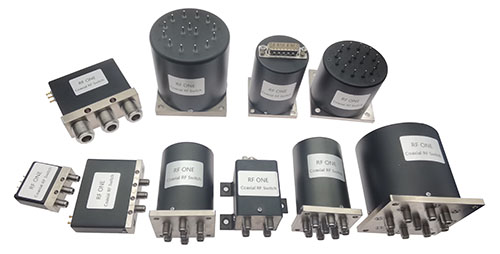Introducing RF Electromechanical Switches
Introduction
In the complex world of electronics, seamless signal control is crucial. A key component that plays a crucial role in this field is the electromechanical coaxial switch. These multifunctional devices are designed to physically alter signal path, offering robustness and reliability in high-power applications. In this article, we will delve deep into the world of these switches, exploring their working principles, applications, and key considerations.
What is an Electromechanical Coaxial Switch?
An electromechanical coaxial switch is a specialized device engineered to physically change the signal path. Unlike solid-state switches, they utilize mechanical components, typically relays, to achieve this. This mechanical action allows for robustness and reliability, particularly in high-power applications.
RF ONE now offers SPDT (Single-Pole-Double-Throw), SPMT (Single-Pole-Multi-Throw) and DPDT (Transfer) switches with SMA, 2.92mm, 2.4mm, 1.85mm connectors from DC to 67GHz. Available in failsafe, latching and normally open actuators.
The Anatomy of Electromechanical Coaxial Switches
An electromechanical coaxial switch comprises several essential components:
Coaxial Ports: These serve as the connection points for the incoming and outgoing signals.
Relays: The heart of the switch, relays physically switch the signal path.
Actuators: These drive the movement of the relays, facilitating the change in signal path.
Housing: Provides structural integrity and protection for the internal components.
Key Considerations for Selecting Electromechanical Coaxial Switches
The frequency range is a critical factor that can't be overlooked. Different applications require switches that can handle specific frequency ranges. It's essential to ensure that the switch you choose aligns with the frequencies pertinent to your system. A mismatch here can lead to signal degradation and performance issues.
Insertion loss refers to the reduction in the signal strength as it passes through the switch. In simpler terms, it's the signal degradation you want to minimize. A RF switch with low insertion loss is essential to maintain signal integrity, ensuring that your signals remain strong and clear throughout the routing process.
Isolation is a measure of how well the switch can prevent unwanted signals from "leaking" between ports. High isolation is crucial because it helps maintain signal purity and prevents interference. Ensuring that signals remain isolated from each other is vital, especially in applications where signal quality is paramount.
The switching speed of the coaxial switch is a critical factor, depending on the application. Some applications require rapid signal routing. In such cases, you need a switch that can change paths swiftly. The switching speed is measured in milliseconds, so be sure to match it with the requirements of your application. RF switches from RF ONE feature high repeatability, high isolation and fast switching speed max 15 ms as well as competitive price and short lead time.
Failsafe: A mode of operation in which the switch moves to the closed position when the actuating voltage is applied and always returns to a predetermined position when the voltage is removed.
Latching: Also called pulse latching, a mode of operation in which the switch remains in a preselected position whenever the actuating voltage is removed or interrupted, and holds that preselected position until a voltage is applied to another position. In order to change to another position the voltage must then be reapplied to the position desired. The latching models can also operate by pulse voltage at a 30 millisecond pulse minimum. The pulse voltage technique can save power and will allow the system to run at cooler temperatures.
Momentary (Normally Open): A mode of operation in which all output ports of the switch are disconnected from the input port until a voltage is applied to maintain a selected position. The switch returns to its open position with the removal of voltage.
Consider the power levels that the switch will be subjected to. Electromechanical coaxial switches are known for their robustness and suitability for high-power applications. Make sure the switch can handle the power levels specific to your requirements. Choosing a switch with insufficient power processing capability may cause malfunctions or damage.
If your application is exposed to harsh environmental conditions, such as extreme temperatures or humidity, please choose a switch with appropriate environmental sealing and robustness. This ensures the switch's durability and longevity, even in challenging settings.
Electromechanical coaxial switches demonstrate human ingenuity in achieving precise signal control. From telecommunications to aerospace, their applications are diverse and crucial. By understanding their internal working principles and considering key factors in selection, people can fully utilize the potential of these indispensable components in electronic systems. Remember, the right switch is not just a component; it's an enabler of seamless communication and functionality in our interconnected world. If you have any needs for coaxial switches, please visit www.rfone.cn or contact us via sales@rfone.cn.
- October 2025
- September 2025
- July 2025
- May 2025
- March 2025
- January 2025
- December 2024
- November 2024
- October 2024
- July 2024
- June 2024
- May 2024
- January 2024
- October 2023
- August 2023
- July 2023
- June 2023
- May 2023
- April 2023
- March 2023
- February 2023
- January 2023
- December 2022
- November 2022
- October 2022
- September 2022
- August 2022
- July 2022
- June 2022
- May 2022
- April 2022
- March 2022
- February 2022
- January 2022
- September 2021
- March 2021
- January 2021
- September 2020
- April 2020
- March 2020
- January 2020
- November 2019
- July 2019
- June 2019
- July 2018
- April 2018
- March 2018
- April 2017
- February 2016
- November 2015
- July 2015
- September 2014
- April 2014

